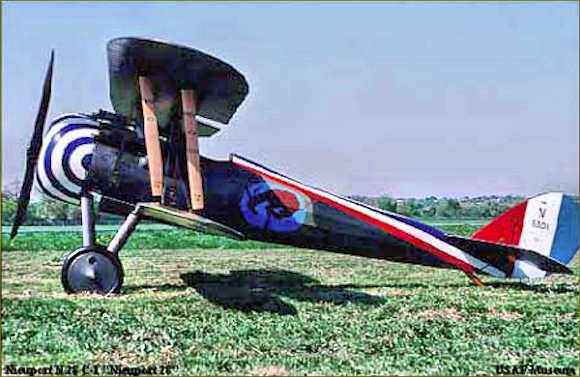 |
| Lt. Eddie Rickenbacker at the Controls of His Nieuport 28C-1 |
At the time of the arrival of the AEF Air Service in France there was insufficient production of the top-of-the line SPAD to allocate this aircraft to the Americans. It was therefore decided to provide the Nieuport 28C-1 to the Americans until such time as the SPAD XIII became available. The AEF eventually took possession of 297 Nieuport 28 aircraft. The pilots of the Lafayette Escadrille had flown earlier models of the Nieuport, the N-11 and N-17 versions.
 |
| USAF Air Museum Example Marked to Represent U.S. 95th Aero Squadron |
Initial assignment of the machines was to the First Pursuit Group (the 27th, 94th, 95th, and 147th Aero Squadrons). Either the 150-hp Gnôme Monosoupape 4-N engine or the 160/170-hp Gnôme 9-N engine powered production machines. The aircraft was armed with two Vickers .303 machine guns—one mounted outboard of the left center-section strut and one on top of the fuselage to the left of the center-line. Some American squadrons used the American Marlin machine gun in lieu of the Vickers gun. For balloon attacks the Vickers guns would be replaced by a single 11 mm Vickers gun, armed with incendiary ammunition, and mounted in the inboard location.
The aircraft was not well received by the Americans because of its inability to effectively engage the Fokker D.VII. It also was both prone to shedding the fabric on the leading edge of the top wing in a steep dive and the engine had a tendency to catch fire. The aircraft served with the A.E.F. for about four months before being replaced by the SPAD XIII.
 |
| San Diego Air Museum Example Marked to Represent the U.S. 94th Aero Squadron ("Hat in the Ring") |
The French-built Nieuport 28 became the first fighter airplane flown in combat by pilots of the American Expeditionary Force (AEF) in World War I. On 14 April 1918, resulted in two victories when Lts. Alan Winslow and Douglas Campbell of the 94th Aero Squadron each downed an enemy aircraft — the first victories by an AEF unit. [ARTICLE]
Despite its unpopularity, American pilots maintained a favorable ratio of victories to losses with it. Many American aces of WWI flew the aircraft, including Captain Eddie Rickenbacker, perhaps the most famous of America’s airmen, who scored 12 of his 26 victories in his Nieuport 28C-1. The less maneuverable, but faster and sturdier, SPAD XIII began replacing the Nieuport 28 in March 1918.
Video of Pilots of the 94th Aero Squadron flying the Nieuport 28C-1:
 |
| Close-up view of the Machine Guns |
TECHNICAL NOTES:
Armament: Two Vickers .303-cal. machine guns
Engine: Gnome 9-N rotary of 160 hp
Maximum speed: 122 mph
Range: 180 miles
Ceiling: 17,000 ft.
Span: 26 ft. 3 in.
Length: 24 ft. 4 in.
Height: 8 ft.
Weight: 1,625 lbs. loaded
Sources: The USAF Museum; The Doughboy Center; San Diego Air Museum

No comments:
Post a Comment